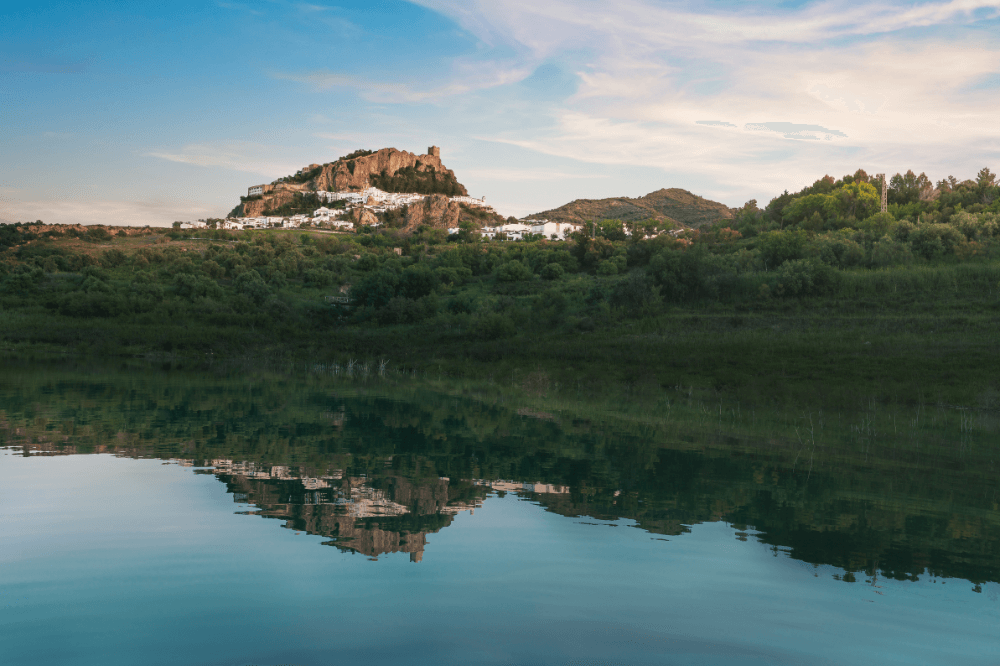Are you planning your trip to Andalusia and feeling overwhelmed by the number of villages you “must” see? We get that feeling.
The White Villages Route can seem like a maze of unfamiliar names (Arcos, Setenil, Zahara), and scattered information makes it hard to create a logical and efficient itinerary.
So, if what you want is to leave behind the stress of planning and genuinely connect with the whitewashed heart of the Andalusian mountains, you’ve come to the right place.
This guide was created to cut through the noise and present you with only the essential white villages that are truly worth your time, optimizing your route to avoid unnecessary detours.
Get ready to turn your route into a smooth and hassle-free journey, enjoying the historical and natural beauty of the Sierra de Cádiz and Málaga.
The White Towns of Andalusia You Can’t Miss
Below, we’ll show you why villages like Ronda or Setenil de las Bodegas are must-see stops, and we’ll also give you local tips to avoid the crowds and find that authentic and memorable experience.
1. Ronda
It’s a stop well worth including on your trip to Andalusia, and the main reason is that it offers a mix of monumental history and dramatic natural landscapes you won’t find in other White Villages.
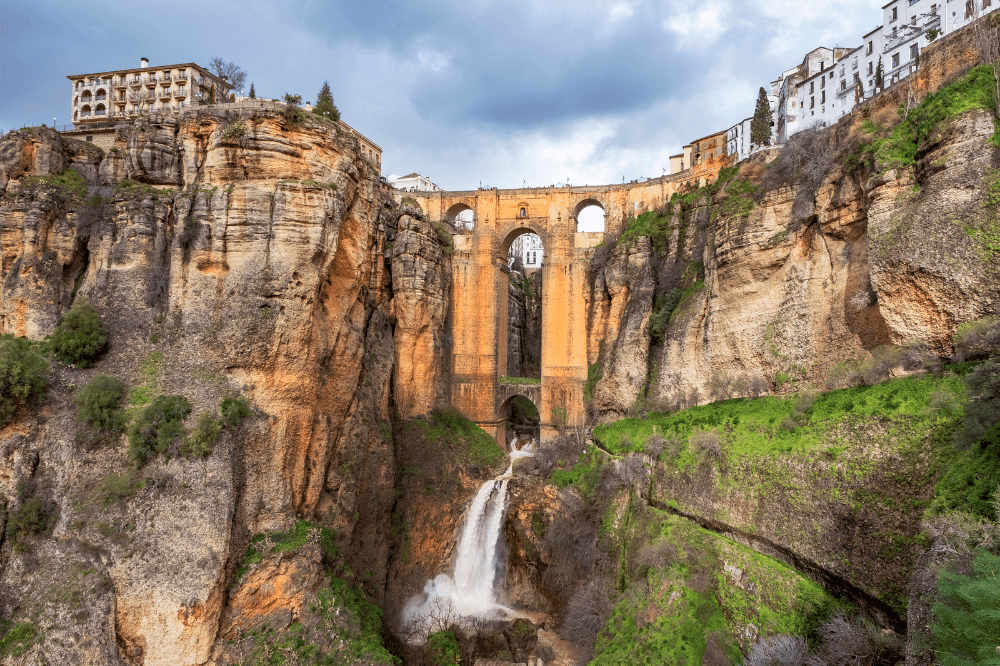
When you arrive in Ronda, the first thing that will catch your eye is undoubtedly the Tajo, a deep gorge nearly 100 meters deep.
Spanning this abyss is the iconic Puente Nuevo, an 18th-century engineering marvel that connects the old town with the more modern neighborhood.
In fact, the best photos are taken from the viewpoints surrounding the bridge.
In addition to this, the historic center, of Moorish origin, is home to the Plaza de Toros de la Maestranza, one of the oldest bullrings in Spain, as well as palaces and stately homes.
So, we recommend taking your time to stroll through the old town, which is a maze of quiet streets with interesting architecture.
To make the most of your visit, here are some practical tips.
First, plan your visit for early morning or sunset, when the light is better and there are fewer crowds.
Also, don’t just view the Puente Nuevo from above; we suggest taking the path down to the Cuenca Gardens or, for a more complete perspective, the trail that descends from Plaza de María Auxiliadora to the base of the Tajo, the effort of the climb back up is well worth it.
Finally, consider spending a night in Ronda so you can enjoy a peaceful dinner and see the Tajo illuminated, which is a completely different experience.
The best gastronomic experience in Ronda.
2. Setenil de las Bodegas
Setenil de las Bodegas is not just another White Village; in fact, it’s one of the most photogenic and unique villages along the Andalusian route.
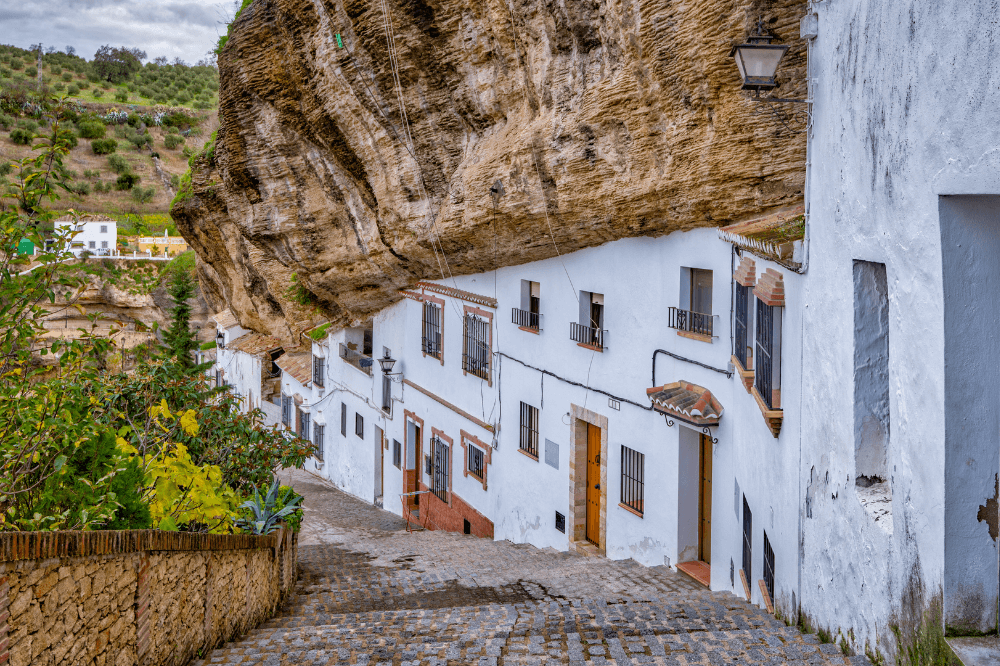
Unlike other villages that sit on hilltops, here the houses are built directly under the rock carved out by the Guadalporcún River.
Its main attraction is walking through its streets to see this unique architecture, where homes use the rock itself as a roof or rear wall, a phenomenon known as “rock shelter.”
This not only creates a visually striking landscape but also provides natural insulation.
The most famous areas are Calle Cuevas del Sol and Calle Cuevas de la Sombra, where massive rock formations loom over visitors.`
You’ll also find small bars and restaurants embedded in these caves, allowing you to have a drink in a truly unique setting.
To make the most of your visit, keep in mind that parking can be a bit tricky due to the narrow streets.
We recommend parking in designated areas in the upper part of town and walking down to the center.
Once there, the visit is very manageable on foot, though you will have to go up and down some hills.
Try to visit outside of midday peak hours to avoid the biggest crowds, especially in summer.
3. Arcos de la Frontera
The visit to Arcos begins at the upper part of the town, which has been declared a Historic-Artistic Site.
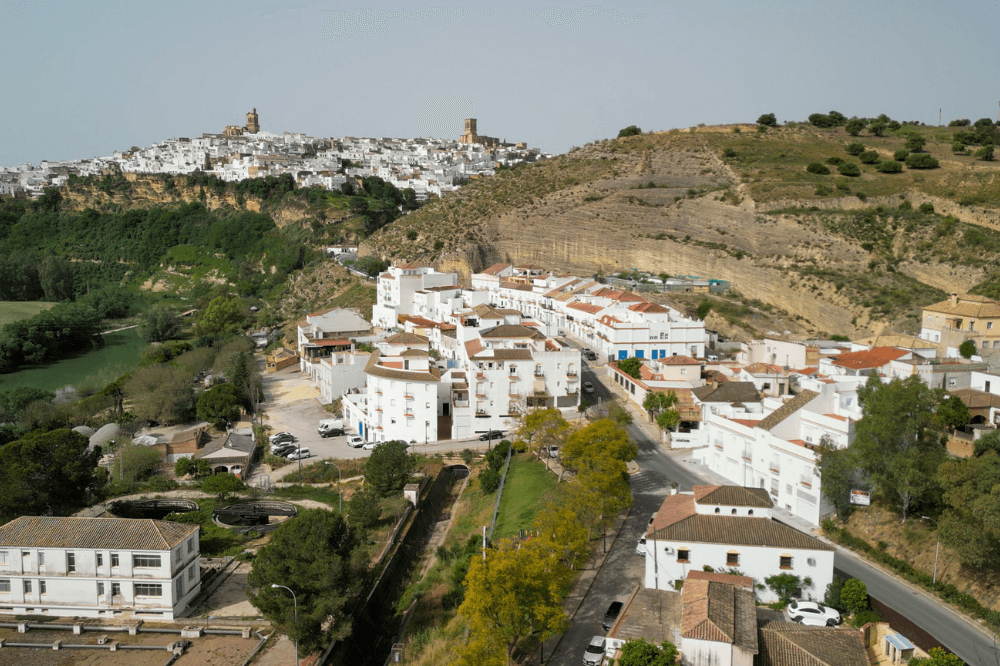
When you arrive, you’ll notice the narrow and winding layout of its streets, a legacy of its Andalusi past.
This is where the most important landmarks are concentrated, such as the Ducal Castle, the Minor Basilica of Santa María de la Asunción, and the Convent of the Mercedarian Sisters.
Beyond the architecture, the true magic of Arcos lies in the views from its viewpoints.
For example, the Mirador de la Peña Nueva offers a vertical view of the cliff, and the Parador de Turismo has a terrace ideal for taking in the landscape.
To have the best experience, plan your route on foot through the old town, as car access to the historic center is very restricted and in fact, the streets are too narrow for many vehicles.
We suggest parking in the lower areas or at the entrance of the village and walking up.
This way, you can more calmly discover the small squares and corners decorated with flowerpots.
Finally, try to stay until sunset, watching the sunlight turn the white walls and the landscape below a golden hue is truly a memorable moment.
4. Zahara de la Sierra
The most distinctive feature of Zahara is the Nasrid castle that crowns the rocky hilltop, a landmark that dominates the landscape of the entire area.
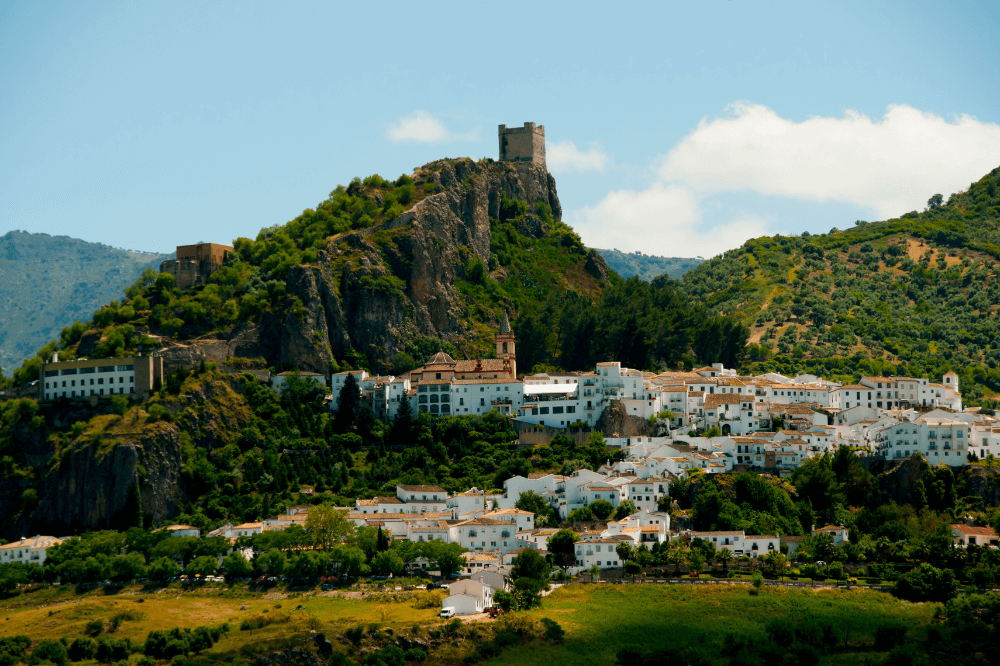
The climb to the castle is a bit demanding, but the effort is worth it, as from the top you’ll get a 360-degree panoramic view, including the white village below and the Zahara-El Gastor reservoir with its striking turquoise waters.
On your way down, you’ll stroll through well-maintained cobblestone streets, lined with typical whitewashed houses and flower-filled balconies.
In addition to this, it’s a perfect starting point for hiking in the Natural Park.
To visit Zahara de la Sierra, we recommend wearing comfortable shoes, as both the climb to the castle and the village streets are quite steep.
It’s also a good idea to stop at the viewpoint just at the entrance of the village before heading up, as it offers the best photo of the whole scene: the village, the castle, and the reservoir.
If you visit the area in summer, the artificial “beach” at the Arroyomolinos recreational area is a great option to cool off by the reservoir.
This way, you can combine cultural sightseeing with a bit of nature and relaxation.
5. Grazalema
This village stands out from the other White Villages because it is fully integrated into its natural surroundings.
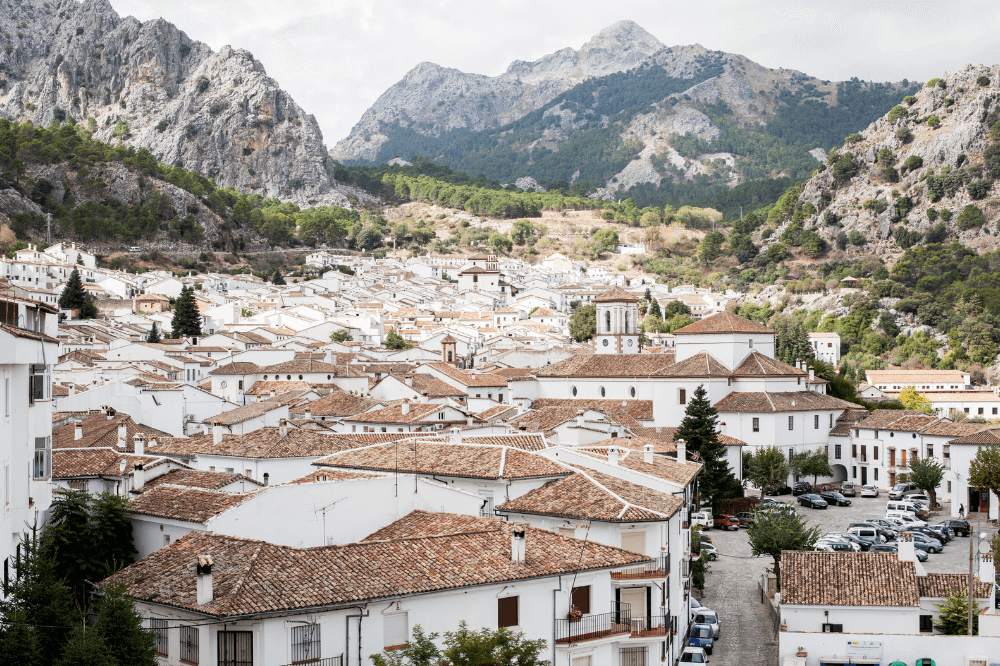
In fact, it’s located within a Natural Park that is also a Biosphere Reserve.
So, if you’re looking for more than just white architecture, this place is ideal for spending time outdoors, as it is the highest point in the province of Cádiz and also the wettest area in mainland Spain.
When you visit the village, you’ll see that its historic center is very well preserved and has even received awards for its beautification.
You can start in Plaza de España, the heart of the village, where you’ll find the Church of Nuestra Señora de la Encarnación.
From there, we recommend heading up to the Mirador de los Peñascos to enjoy a 360-degree view of the valley and surrounding mountains.
However, the biggest attraction in Grazalema is its natural environment.
So, make sure to dedicate time to hiking and visit the famous pinsapo forest a type of fir tree that only grows in this region, a relic from the Tertiary era.
Explore our experiences with local cooks in Andalusia.
Local Tips for a Better Experience
Here are some tips to help you get around and enjoy the area like a local, because we know the small details can make a big difference on your trip.
Avoid the hottest months
The best time to visit is in spring (March, April, May) or autumn (September, October, November).
Keep in mind that in summer (July and August), temperatures can be extremely high in inland Andalusia, making midday strolls much less enjoyable.
Plus, in spring you’ll see green fields, which make the landscape even more beautiful.
Park outside the historic center
Most of these villages were built in medieval times, so their centers are labyrinths of very narrow and steep streets.
For this reason, we advise against trying to drive into the heart of the village.
Look for designated parking areas at the lower part or entrance of town this way, you’ll avoid traffic jams and stressful situations.
Dress and wear appropriate footwear
Wear comfortable shoes with good grip.
As mentioned, most villages are built on hillsides or cliffs, which means you’ll face many slopes and stairways, often cobbled.
Also, don’t forget to bring a hat and sunscreen, as the sun reflecting off the white façades can be very intense.
Combine visits with experiences
Don’t overwhelm yourself by trying to see three or four villages in a single day, you’ll lose the essence.
Ideally, dedicate half a day to one village and pair it with another activity in the area, such as a hiking route in Grazalema or Zahara de la Sierra, tasting Payoyo cheese, or visiting a winery in Ronda or Jerez.
This way, your trip will be more varied and less exhausting.
Don’t Forget the Viewpoints
The true magic of these villages lies in their placement within the landscape.
We always recommend looking for the official viewpoint or scenic spot at the entrance of the village, as that’s where you’ll get the most complete panoramic photo of the white village set against the green backdrop of the mountains.
The Mirador de la Peña Nueva in Arcos or the view of the Zahara reservoir are must-stops before entering the village.
Ask at the Handicraft Shops
Many of these villages are known for their local products, like leather goods in Ubrique or wool blankets in Grazalema.
A great way to interact with locals is by visiting these workshops or artisan shops, where they’ll often give you the best tips on where to eat well and which hidden corners are worth exploring.
Discover the Local Flavors of Andalusia with Sazón The Folk Cook
You’ve explored the unfiltered beauty of the White Villages, marveled at their hilltops and alleyways now it’s time to dive into their true soul.
At Sazón, we invite you to go from tourist to honored guest.
You won’t just taste homemade dishes crafted with the same care as an Andalusian grandmother, you’ll experience the culture in a way no guidebook can offer: unfiltered.
So, if your goal is to truly connect with Andalusia, don’t stop at the postcard.
Book your culinary experience with Sazón now! Come honor the flavors of Spain, celebrate the hands that created them, and take home a gastronomic memory as unique as you are.
Are you ready to discover the culture through its most authentic seasoning?
Explore our experiences with local cooks.

